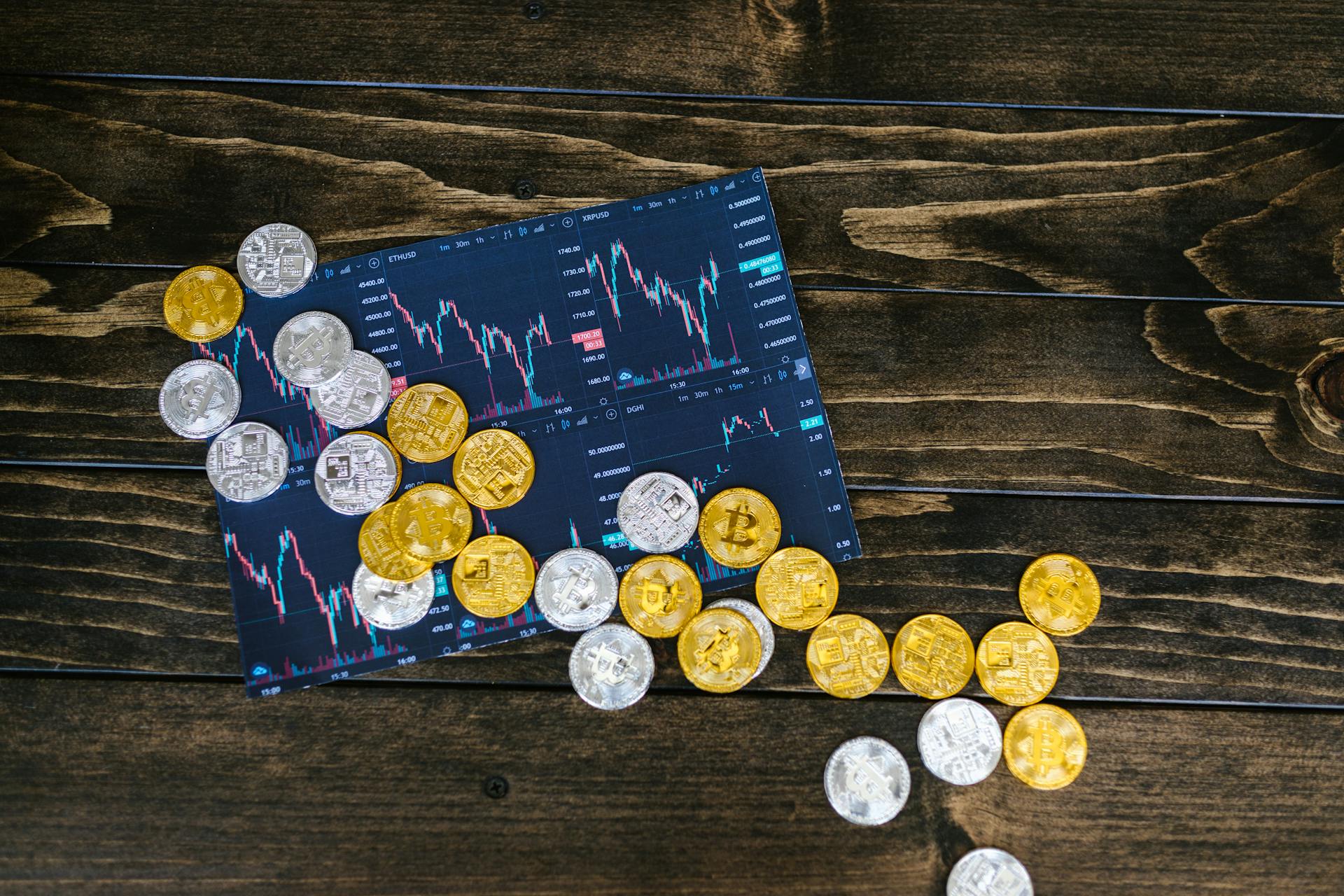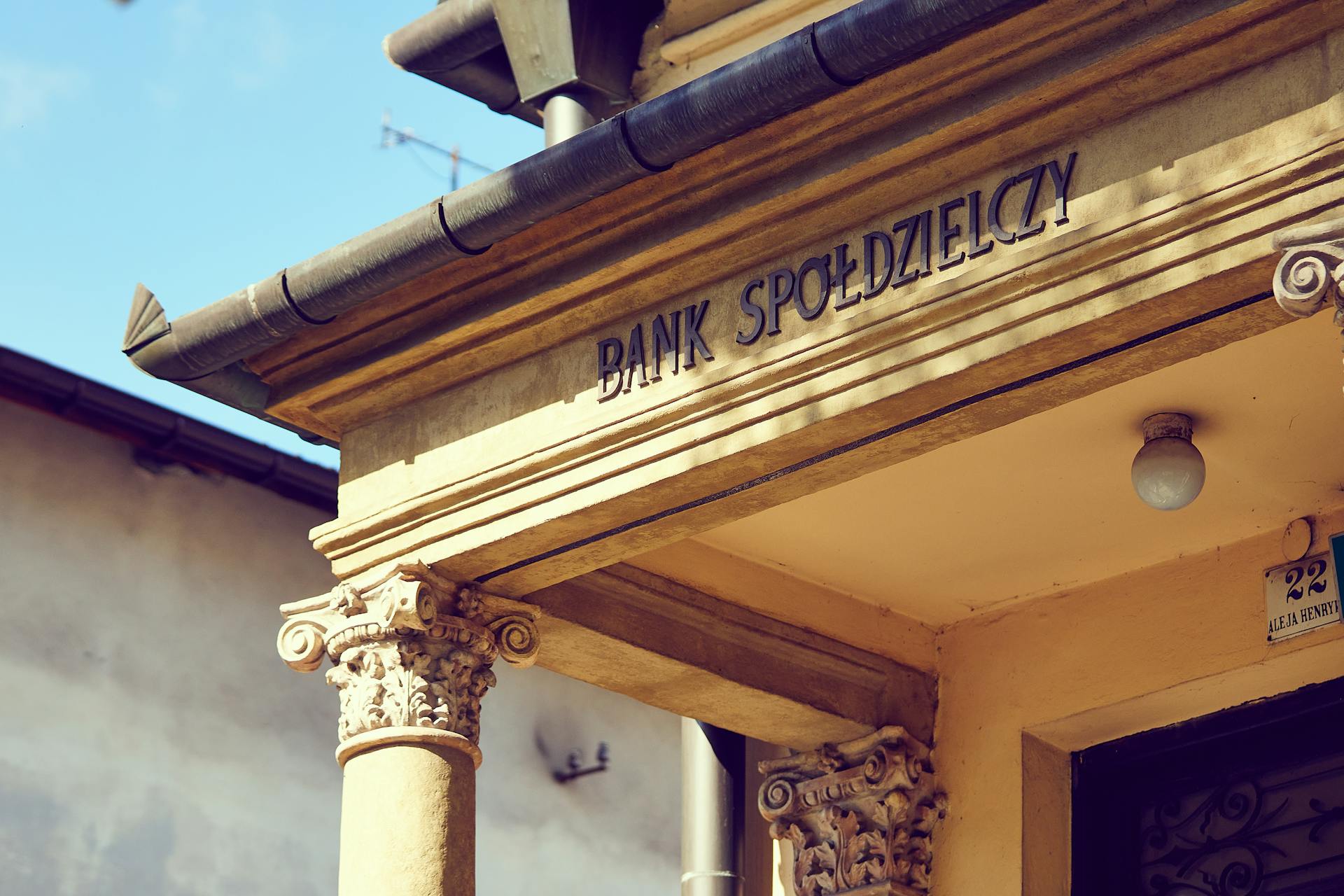
The Libor rate scandal was a major financial scandal that involved the manipulation of the London Interbank Offered Rate, a key benchmark used to set interest rates for trillions of dollars' worth of financial instruments. The scandal was a result of a culture of greed and a lack of oversight.
The scandal was uncovered in 2008, when it was revealed that several major banks had been submitting false Libor rates to benefit their trading positions. This manipulation had a ripple effect on the global economy, causing widespread economic instability.
The Libor rate scandal led to significant consequences, including fines and penalties totaling over $9 billion for the banks involved. It also led to a major overhaul of the way Libor is set and regulated.
A different take: Why Are Mortgage Rates Pegged to Rate Set by Fed
Regulatory Actions
Regulatory actions were taken in response to the Libor rate scandal.
Regulators focused on major banks such as Bank of America Corp., Citigroup Inc., and UBS AG in their probe of Libor rate manipulation. The US Department of Justice conducted a criminal investigation into Libor abuse, looking into direct communication between traders and bankers before the rates were set.
The Canadian Competition Bureau also carried out an investigation into price fixing by five banks of the yen denominated Libor rates. Court documents revealed that the bureau had been pursuing the matter since at least January 2011, with a whistleblower turning on fellow conspirators in exchange for immunity.
The FDIC filed a massive lawsuit in the Southern District of New York against the U.S. dollar Libor rate-setting banks, seeking damages for alleged harm to failed banks.
Central Bank Awareness
In November 2008, the Governor of the Bank of England, Mervyn King, told the UK Parliament that banks were unwilling to lend to each other, making Libor a rate at which banks do not lend to each other.
The New York Federal Reserve was aware of industry concerns that the Libor rate was being under-reported as early as November 2007, as indicated in Bank of England minutes.
A Barclays employee told a New York Fed analyst in 2008 that they knew they were not posting an honest Libor rate, but were doing it to avoid unwanted attention.
For another approach, see: New Jersey Student Loan Program
The New York Fed President Tim Geithner wrote a memo to Bank of England chief Mervyn King in early 2008, suggesting ways to "fix" Libor, but there is no evidence that his recommendations were acted upon.
In October 2008, a Barclays employee told a New York Fed representative that Libor rates were still "absolute rubbish."
Suggestion: York Rating
Europe
In Europe, scholars are pushing for far-reaching banking reforms to address the crisis of confidence.
These reforms aim to adopt binding regulations that go beyond the Dodd-Frank Act, particularly in France where experts from SFAF and World Pensions Council (WPC) are advocating for separation of powers in European Union law.
The Libor scandal has led mainstream opinion leaders like the Financial Times to call for an EU-wide "Glass-Steagall II" to limit conflicts of interest and anti-competitive practices.
This move is seen as a necessary step to end exclusive dealing and promote fair competition in the European banking sector.
See what others are reading: De Banking Scandal
Fines
Fines can be a significant concern for businesses and individuals alike. Fines can range from $10,000 to $100,000 or more, depending on the severity of the violation.
The maximum fine for a repeat offender can be twice the amount of the original fine. For example, if the original fine was $50,000, the maximum fine for a repeat offender would be $100,000.
Fines can be imposed for a wide range of regulatory infractions, including failure to obtain necessary permits and licenses. In some cases, fines can be reduced or waived if the violator takes corrective action and complies with regulatory requirements.
The total amount of fines imposed in a given year can be substantial. For instance, in one year, a regulatory agency imposed fines totaling $5 million.
Discover more: 10/1 Arm Mortgage Rates Today
Claims and Lawsuits
The Libor rate scandal has led to numerous lawsuits and claims against the banks involved. Southern District of New York Judge Naomi Reice Buchwald substantially granted the motion to dismiss in the consolidated Libor-scandal antitrust litigation on March 29, 2013.
The consolidated Libor-scandal antitrust and RICO claims were dismissed by Judge Naomi Reice Buchwald on March 29, 2013, despite the defendants having paid substantial regulatory fines and penalties.
The Libor-scandal based securities suit filed against Barclays and certain of its directors and offices initially got dismissed, but the Second Circuit vacated a part of the dismissal ruling and returned the case to the district court for further proceedings.
The federal credit union regulatory agency, NCUA, has filed a new action against Libor rate-setting banks alleging violation of the Sherman Act, even after the federal judge presiding over the consolidated Libor antitrust litigation granted the defendants' motion to dismiss.
Judge Shira Scheindlin granted defendants' motion to dismiss the Libor-scandal related securities suit against Barclays and two of its former executives on May 13, 2013.
Discover more: Mortgage Rates Are Rising after the Federal Reserve Rate Cut
Libor Rate Details
The London Interbank Offered Rate (LIBOR) was a benchmark interest rate for short-term loans between major global banks. It was phased out in 2023.
LIBOR was calculated and published each day by the Intercontinental Exchange (ICE), but it was phased out due to scandals and questions around its validity as a benchmark rate.
The LIBOR one-week and two-month USD LIBORs stopped publishing as of December 31, 2021, as part of the phaseout.
London Interbank Rate
The London Interbank Rate, also known as LIBOR, was a benchmark interest rate for short-term loans between major global banks.
It was phased out in 2023 and replaced by the Secured Overnight Financing Rate (SOFR).
LIBOR was a globally accepted key benchmark for the cost of borrowing between banks from 1986 to the 2000s.
The rate was calculated and published each day by the Intercontinental Exchange (ICE), but scandals and questions around its validity as a benchmark rate resulted in it being phased out.
LIBOR one-week and two-month USD LIBORs stopped publishing as of Dec. 31, 2021, as part of the phaseout.
Some USD rates are still published using a synthetic methodology, but these rates will cease in Sept. 2024.
The LIBOR rate was used to determine the cost of borrowing for many financial products, including mortgages.
Homeowners in the US filed a class action lawsuit in October 2012 against twelve of the largest banks which alleged that Libor manipulation made mortgage repayments more expensive than they should have been.
The LIBOR scandal led to changes in the way the rate was supervised, with the British Bankers Association (BBA) losing its responsibility to the Intercontinental Exchange's Benchmark Administration (IBA).
The IBA is an independent U.K. subsidiary of the private U.S.-based exchange operator, Intercontinental Exchange (ICE).
LIBOR is now commonly known as ICE LIBOR.
The FCA announced that it will support LIBOR only until 2021, at which point it hopes to transition to an alternative system.
The New York Federal Reserve launched a possible LIBOR replacement in April 2018 called the Secured Overnight Financing Rate (SOFR).
SOFR is based on short-term loans observed in the repo market, which theoretically makes it a more accurate indicator of borrowing costs.
The LIBOR rate rigging scandal involved major banks colluding to manipulate the LIBORs to bump up the profits of traders who were holding positions in LIBOR-based financial securities.
Major banks and financial institutions faced heavy fines and punitive actions were taken against their employees who were found to be involved in the malpractice.
The scandal was also one of the primary reasons why LIBOR shifted from BBA administration to ICE.
LIBOR was susceptible to rate-rigging because banks could submit artificially high or low estimates of their lending rates.
The new metric, SOFR, uses actual lending rates, not the banks' estimations.
Worth a look: Ice Libor
How Was It Calculated?
The LIBOR calculation process was quite complex, but it's essential to understand how it was done. The IBA had a designated panel of global banks for each currency and tenor pair, with 16 major banks constituting the panel for U.S. dollar LIBOR.
These panel banks were selected based on their significant role in the London market, and the selection process was held annually. Only those banks with a significant role in the London market were considered eligible for membership on the ICE LIBOR panel.
The IBA proposed a new methodology called the Waterfall Methodology in April 2018, which suggested a standardized, transaction-based, data-driven approach for determining LIBOR. This new method involved three levels: transaction-based, transaction-derived, and expert judgment.
Here are the three levels of the Waterfall Methodology:
- Level 1: Taking a volume-weighted average price (VWAP) of all eligible transactions that a panel bank may have assigned a higher weighting for transactions booked closer to 11 a.m. London time.
- Level 2: Taking submissions based on transaction-derived data from a panel bank if it does not have a sufficient number of eligible transactions to make a Level 1 submission.
- Level 3: Submitting the rate at which it could finance itself at 11 a.m. London time, with reference to the unsecured, wholesale funding market, when a panel bank fails to make a Level 1 or a Level 2 submission.
The IBA calculated the LIBOR using a trimmed mean approach, which involves eliminating a small specified percentage of the largest and smallest values before calculating the mean. Figures in the highest and lowest quartile are thrown out, and averaging is performed on the remaining numbers.
Curious to learn more? Check out: What Does the Fed Rate Cut Mean for Mortgage Rates
Rate Rigging and Consequences
The LIBOR rate rigging scandal was a major scandal that involved major banks colluding to manipulate the LIBORs, which is a global benchmark standard for interest rates. This led to artificially low LIBORs being submitted to keep traders at their preferred levels, resulting in bumped up profits for those holding positions in LIBOR-based financial securities.
Major banks and financial institutions such as Barclays, ICAP, Rabobank, Royal Bank of Scotland, UBS, and Deutsche Bank faced heavy fines and punitive actions against their employees involved in the malpractice. The scandal was also one of the primary reasons why LIBOR shifted from BBA administration to ICE.
The LIBOR was susceptible to rate-rigging because banks could submit artificially high or low estimates of their lending rates. This allowed them to manipulate the rates and gain an unfair advantage.
Regulatory scrutiny, including investigations by the U.S. Department of Justice, was launched following reporting by The Wall Street Journal in 2008. Similar investigations were also launched in the U.K. and Europe.
In court documents filed in Singapore, Royal Bank of Scotland (RBS) trader Tan Chi Min told colleagues that his bank could move global interest rates and that the Libor fixing process in London had become a cartel. Tan's statements and instant messages with other traders revealed a highly lucrative money-making cartel.
Investigations and Reactions
Investigations into the Libor rate scandal were underway in multiple countries, including the US and Canada. Regulators were focusing on several major banks, including Bank of America Corp., Citigroup Inc., and UBS AG.
The US Department of Justice was conducting a criminal investigation into Libor abuse, which included allegations of traders being in direct communication with bankers before the rates were set. This allowed them to have insider knowledge into global instruments.
The Canadian Competition Bureau was also investigating price fixing by five banks of the yen denominated Libor rates. Court documents revealed that the banks allegedly colluded to fix the Libor rates, with traders communicating with each other to see a higher or lower yen LIBOR to aid their trading positions.
Intriguing read: Usd Libor Rate
The US Congress began investigating the scandal in July 2012, with Senate Banking Committee Chairman Tim Johnson planning to question Treasury Secretary Timothy Geithner and Federal Reserve chairman Ben Bernanke. Republican US Senators Chuck Grassley and Mark Kirk accused Geithner of knowledge of the rate-fixing and inaction, which contributed to litigation that threatened to clog courts with multi-billion dollar class action lawsuits.
The cost of the scandal could be significant, with one estimate suggesting it may exceed the cost of asbestos lawsuits.
WSJ Study
The WSJ study, released on 16 April 2008, suggested that some banks might have understated borrowing costs they reported for the Libor during the 2008 credit crunch.
The study found that this underreporting may have misled others about the financial position of these banks.
The BBA responded by claiming that the Libor continued to be reliable even in times of financial crisis, but other authorities contradicted this claim.

The Bank for International Settlements stated in its March 2008 Quarterly Review that "available data do not support the hypothesis that contributor banks manipulated their quotes to profit from positions based on fixings."
In October 2008, the International Monetary Fund published its regular Global Financial Stability Review, which found that "Although the integrity of the U.S. dollar Libor-fixing process has been questioned by some market participants and the financial press, it appears that U.S. dollar Libor remains an accurate measure of a typical creditworthy bank's marginal cost of unsecured U.S. dollar term funding."
A study by economists Connan Snider and Thomas Youle, in April 2010, corroborated the results of the earlier Wall Street Journal study, concluding that the Libor submissions by some member banks were being understated.
The reason for this underreporting, according to Snider and Youle, was not that the banks were trying to appear strong, especially during the 2007–2008 financial crisis, but rather that the banks sought to make substantial profits on their large Libor interest-linked portfolios.
Consider reading: Dollar Libor Rate
Regulatory Investigations
Regulatory investigations into the Libor scandal were underway in multiple countries. The Wall Street Journal reported in March 2011 that regulators were focusing on Bank of America Corp., Citigroup Inc., and UBS AG in their probe of Libor rate manipulation.
Regulators were looking into the possibility that traders were in direct communication with bankers before the rates were set, giving them insider knowledge. A trader from the Royal Bank of Scotland claimed that it was common practice among senior employees at his bank to make requests to the bank's rate setters as to the appropriate Libor rate.
The US Department of Justice was conducting a criminal investigation into Libor abuse, with court documents revealing that traders could net millions of dollars for each basis point moved. The Canadian Competition Bureau was also investigating price fixing by five banks of the yen denominated Libor rates.
The alleged participants in the Canadian investigation included the Canadian branches of the Royal Bank of Scotland, HSBC, Deutsche Bank, JP Morgan Bank, and Citibank, as well as ICAP, an interdealer broker. The Competition Bureau had been pursuing the matter since at least January 2011.
Here are the regulatory bodies involved in the investigations:
- US Department of Justice
- Canadian Competition Bureau
- Wall Street Journal
- New York Federal Reserve
- House Financial Services Committee
- Senate Banking Committee
Reactions

The reactions to the scandal have been swift and severe. The cost to colluding and suspect banks from litigation, penalties, and loss of confidence may drive down finance industry profits for years. The cost of litigation from the scandal may exceed that of asbestos lawsuits.
Banks are facing significant financial burdens as a result of the scandal. This is likely to have a ripple effect throughout the finance industry, impacting profits for years to come.
Frequently Asked Questions
What organization was responsible for calculating the LIBOR rate before the scandal?
The British Bankers' Association (BBA) was responsible for calculating the LIBOR rate before the 2012 scandal. It compiled the average interest rate banks charged each other for loans.
Why is LIBOR being abandoned?
LIBOR is being abandoned due to a scandal exposing its manipulability, which was made possible by its lack of a real-world basis. Regulators have decided to ban it to restore trust in the financial market.
Who went to jail for the Libor scandal?
Tom Hayes and Carlo Palombo were two City traders who served prison time for their roles in the Libor scandal. They were among 37 traders prosecuted for manipulating rate benchmarks.
Sources
- https://www.dandodiary.com/articles/libor-scandal/
- https://www.justice.gov/opa/pr/barclays-bank-plc-admits-misconduct-related-submissions-london-interbank-offered-rate-and
- https://www.investopedia.com/terms/l/libor.asp
- https://en.wikipedia.org/wiki/Libor_scandal
- https://www.investopedia.com/terms/l/libor-scandal.asp
Featured Images: pexels.com


